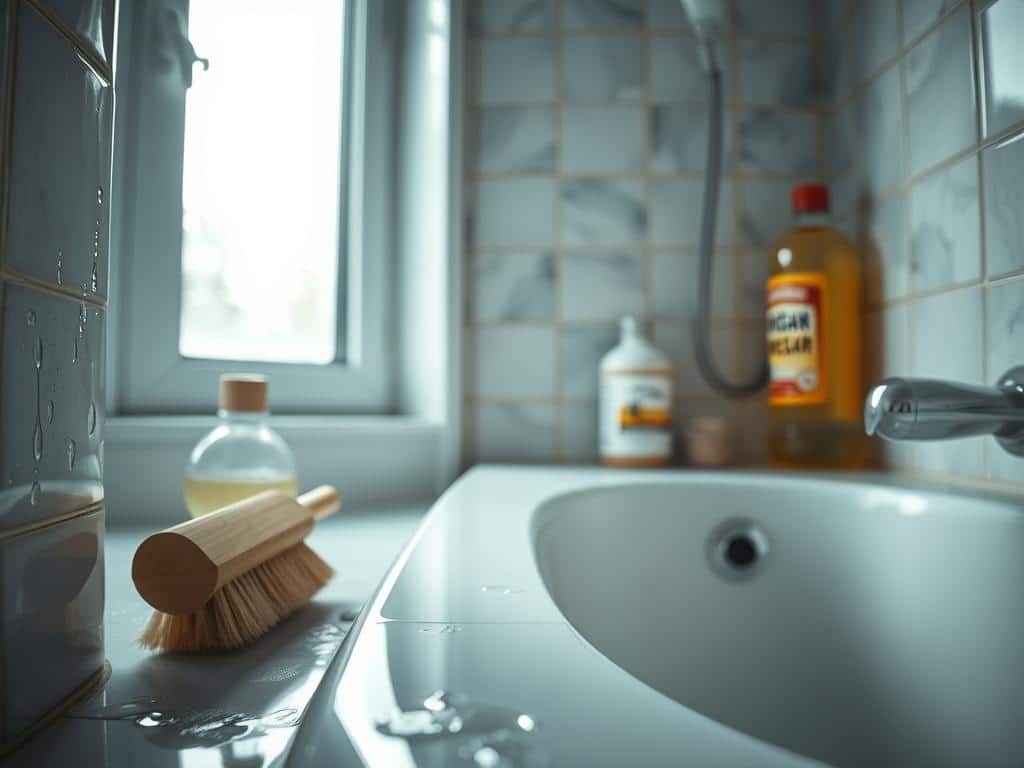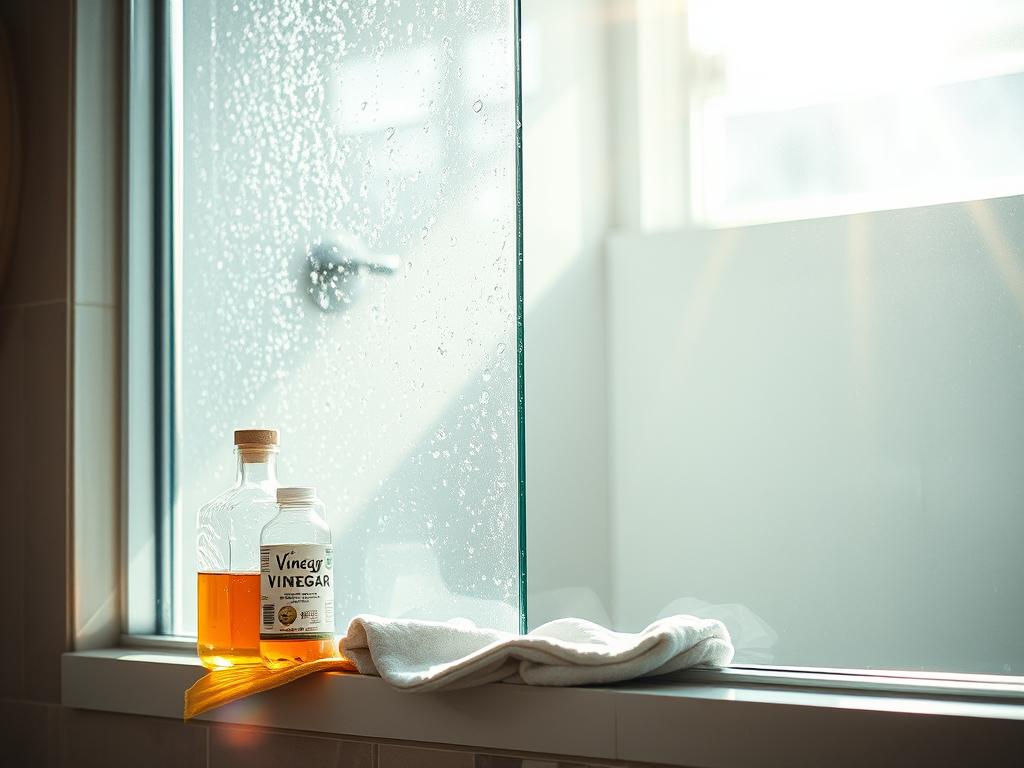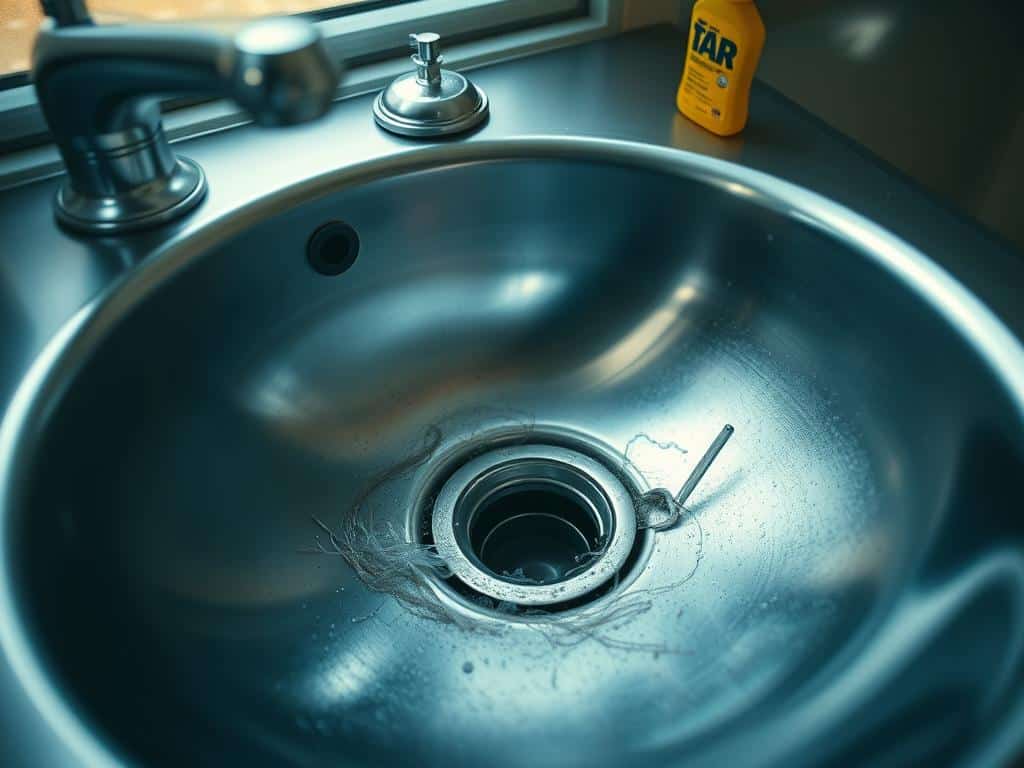
Hard water stains in your bathroom are a common issue. They happen because of minerals like calcium and magnesium. These minerals leave marks on places where water goes often. This includes showers, tubs, glass, and sinks. While these stains won’t hurt you, they make your bathroom look less clean and shiny.
There are effective ways to get rid of these stains, though. You can use things you already have at home. With the right tips, you can make your bathroom look bright and clean again. Keep your bathroom looking its best with these ideas.
Understanding Hard Water and Its Effects
Hard water has a lot of dissolved minerals, mainly calcium and magnesium. These minerals can create deposits that make surfaces in your bathroom look dull and spotty. Learning about hard water and its effects is key to handling the issues it brings. Issues like spotting, film, and needing stronger cleaning efforts.
The level of water hardness is measured by how much calcium and magnesium it has, in mg/L or ppm. This measurement tells us how severe the hardness is. It ranges from soft to very hard. Though hard water isn’t directly harmful to health, it affects your daily life and how you maintain your home.
Hard water can damage bathroom surfaces over time. Minerals form a white or off-white buildup on things like faucets, tubs, and showerheads. This buildup can harm plumbing fixtures and shorten appliance life. It also causes problems like bad soap lathering and spots on glassware.
Hard water deposits minerals as it flows through plumbing, creating scale or limescale. This damage isn’t just cosmetic—it also reduces water heater efficiency by coating heating elements, which ups energy use. Hard water’s effects are widespread, from making your clothes feel odd after washing to reducing your plumbing’s lifespan.
Keeping up with cleaning and maintenance helps fight hard water’s effects. Using gentle cleaners, like those in a cleaning guide, can protect surfaces. Also, water softening systems are a good investment against hard water.
Understanding and tackling hard water makes for better maintenance and a nicer home to live in. Cleaning surfaces often and taking steps like installing water softeners can cut down on deposits. This improves household efficiency a lot.
- Measures water hardness in mg/L or ppm
- Classifies degrees of water hardness
- Directs connection between hard water and bathroom surface damage
- Impacts of mineral deposits on plumbing and appliances
- Regular maintenance suggestions
Essential Cleaning Supplies and Tools
To fight hard water stains in your bathroom, you need the right supplies and tools. Learn which natural cleaning ingredients and tools can make your bathroom shine. We’ll go over the must-have ingredients and tools for a spotless bathroom.
Common Household Ingredients
Several household items are great for removing hard water stains naturally:
- Vinegar: Its acid breaks down mineral deposits. Use it on most bathroom surfaces, but not on soft stones like marble.
- Baking Soda: Its slight roughness helps remove tough stains. Mixed with vinegar, it cleans even better.
- Hydrogen Peroxide: Great for soap scum and hard water stains. Apply, wait 15 minutes, then scrub.
Using these ingredients with the right techniques can make your bathroom much cleaner.
Cleaning Tools
You also need the best tools together with natural cleaners for fighting hard water stains:
| Tool | Function |
|---|---|
| Spray Bottle | Perfect for spraying a vinegar-water mixture. |
| Sponge | Great for applying baking soda paste and scrubbing surfaces. |
| Squeegee | Helps clean glass surfaces and prevent streaks. |
| Scrub Brush | Ideal for cleaning tough grout lines and hard-to-reach areas. |
| Microfiber Towel | Best for drying surfaces and leaving them streak-free. |
Having these supplies on hand makes tackling hard water stains easier and keeps your bathroom clean.
Removing Hard Water Stains from Shower and Bathtub
Dealing with hard water stains in your bathroom is frustrating. These stains come from high levels of minerals like calcium and magnesium. They can dull the appearance of your shower and bathtub. But using the right natural stain removal methods and bathroom cleaners can help a lot.
Using Vinegar and Baking Soda
One popular way to get rid of hard water stains is using vinegar and baking soda. Start by mixing white vinegar and water equally in a spray bottle. Then, spray it all over your shower and bathtub areas. Let it sit for 15 minutes. This lets the vinegar’s acid dissolve the mineral buildups.
For tougher stains, mix baking soda with water or vinegar to make a paste. Spread this paste on the stains and scrub with a brush. This natural combo gets rid of stains without harmful chemicals. It’s safe for your home and the environment.
Alternative Methods
There are also other natural and store-bought options. Mixing water and rubbing alcohol works well, just spray it on the stains. You can also use commercial cleaners like CLR for difficult stains. They clean well without harming your surfaces.
But remember, don’t use vinegar on soft stones like marble. Look for cleaners made for these types of surfaces instead. Keeping your bathroom clean and dry stops new stains. Wipe your bathroom surfaces with a microfiber towel for a minute or two every day. This will keep the mineral deposits from building up again.
Cleaning Hard Water Stains Off Bathroom Glass Surfaces
Keeping glass surfaces in the bathroom clean can be tough because of hard water stains. Knowing how these stains form and the best ways to remove them is key. This is why clear glass maintenance matters a lot for a shiny bathroom.
One top method to get rid of hard water stains involves a mix of white vinegar and water. The acid in vinegar helps remove the mineral build-up that causes these stains. Spray this mix on the glass and wait at least 30 minutes for it to work.

If vinegar doesn’t do the trick, try using a baking soda paste instead. Mix water and baking soda to make a soft scrub. Put this paste on the stains, scrub, and rinse it off well.
Here’s a simple guide to these cleaning steps:
- Mix distilled white vinegar or lemon juice with water in a spray bottle.
- Spray it on the glass where you see hard water stains.
- Let it stay for 30 minutes to dissolve the minerals.
- Wipe it off with a wet, clean cloth.
- For tougher stains, use a mix of water and baking soda.
- Scrub softly, then wash off with distilled water.
- Dry the glass with a soft cloth to avoid more spots.
Preventing hard water stains on shower doors is easier with a squeegee. Use it after each shower to keep the glass clear. Cleaning every two weeks is also a good idea. It keeps the bathroom looking great.
Below is a summary of the best cleaning solutions and how to use them:
| Cleaning Solution | Application | Effectiveness |
|---|---|---|
| Vinegar and Water | Spray and leave for 30 minutes | Breaks down mineral deposits |
| Baking Soda Paste | Apply and scrub gently | Removes persistent stains |
| Lemon and Salt | Scrub onto surface | Effective on stainless steel |
By cleaning your glass surfaces regularly, you can avoid hard water stains. This keeps your bathroom clean and bright.
Removing Hard Water Stains from Toilets
Getting rid of hard water stains in toilets can be tough. These stains come from minerals like magnesium and calcium. To keep your toilet clean and fresh, you need to work at it regularly. Here’s a simple guide to remove those stubborn stains using vinegar and baking soda.
First, get distilled white vinegar, baking soda, and a toilet bowl cleaner. Sprinkle baking soda on the stains in the bowl. Then, pour vinegar over the baking soda. This mix will fizz and helps break down the mineral deposits.
Let the mix sit for about 15 minutes. Then, it’s time to scrub with a toilet brush. This should remove the hard water stains. If stains are tough, you might have to repeat the process or let the mix sit longer.
If you like using store products, try Bon Ami or Bar Keepers Friend. They are great for cleaning porcelain. They can remove limescale and rust from hard water, too.
For a comparison of cleaning methods, look at the table below:
| Cleaning Method | Ingredients/Tools Needed | Effectiveness | Frequency |
|---|---|---|---|
| Vinegar & Baking Soda | White vinegar, Baking soda, Toilet brush | High | Twice a month |
| Commercial Cleaners (Bon Ami, Bar Keepers Friend) | Commercial cleaner, Toilet brush | High | Weekly |
| Dishwasher Tablets | Dishwasher tablet, Toilet brush | Moderate (Needs overnight soaking) | As needed |
Keeping up with regular cleaning stops hard water stains. Use an acid-based cleaner weekly. Also, use vinegar and baking soda twice a month for best results.
Stick to these cleaning habits. Your toilet will stay stain-free and your porcelain will look clean and shiny.
How to Clean Faucets and Shower Heads
Keeping your faucets and shower heads clean is vital. Regular cleaning makes them look good and prevents mineral buildup from hard water. Here’s how to clean your bathroom fixtures effectively.
Soaking Method with Vinegar
The soaking method uses white vinegar to clean. Vinegar is great for breaking down minerals like calcium. Just soak a cloth in vinegar and wrap it around the fixture.
- Soak a clean cloth in white vinegar.
- Wrap the cloth around the faucet or shower head, ensuring complete coverage.
- Leave it to soak for at least an hour to dissolve any buildup.
- Rinse thoroughly with water and dry with a microfiber cloth to prevent further buildup.
If shower heads are clogged, take them apart and soak them in vinegar overnight. Then, scrub them with a toothbrush to remove any leftovers.
Using Commercial Cleaners
If stains are tough, try commercial cleaners like CLR. Make sure to follow the product’s instructions carefully for the best and safest results:
- Apply the commercial cleaner to the fixture as directed.
- Leave it for the recommended duration, usually around 10-15 minutes.
- Scrub any tough spots with a soft brush.
- Rinse thoroughly with water and dry with a clean cloth.
When using strong chemicals, wear gloves to protect your skin. It’s important to rinse off all residues to keep fixtures shining and prevent buildup.
Using vinegar or commercial cleaners will improve your bathroom fixture care. Regular cleaning is the key to prevention. For more tips, check out Puracy’s hard water guide.
Preventing Future Hard Water Stains
To keep your bathroom clean, it’s key to prevent hard water. Start by drying off wet areas right after using them. This stops water from drying and leaving calcium and magnesium behind. Doing this daily keeps your bathroom looking great.
Wipe Down Surfaces
Make sure to wipe down surfaces after showers or baths. Use a squeegee or a microfiber cloth. This action keeps water spots and mineral deposits from forming. Keeping these areas dry lessens the chances of hard water stains.
Invest in a Water Softener
For a lasting fix against hard water stains, think about getting a water softener. Such devices take out minerals like calcium and magnesium from your water. Less minerals mean fewer hard water stains. You get cleaner bathroom surfaces.
Brands like Rayne Water offer top-notch water softeners. They have been trusted since 1928. With these, you ensure your home has quality water everywhere.
Conclusion
Dealing with hard water stains in the bathroom might seem tough. But, with the right steps and continuous effort, you can tackle it. It’s important to grasp how magnesium, calcium, and other minerals affect your fixtures. These minerals, when present in large amounts, create visible hard water stains and soap scum as the water evaporates.
Using items like vinegar, baking soda, and citric acid is a smart move. These natural cleaners are budget-friendly and good for the planet. By using them regularly, you can break down mineral buildup. This keeps hard water stains away. Also, cleaning your bathroom often, including drying surfaces with a squeegee, keeps it sparkling.
For a more lasting solution, think about getting a water softener system. Water softeners lower the mineral levels in your water. This means less hard water stains forming. Opting for this solution can save you a lot of cleaning time. Always remember, keeping up a regular cleaning schedule is crucial for a shiny, stain-free bathroom.



